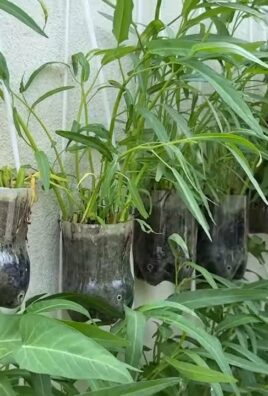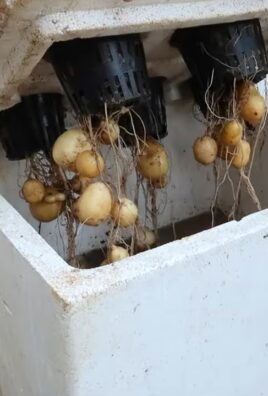Grow Lemons Indoors Easily? Absolutely! Imagine plucking a sun-kissed lemon, bursting with flavor, right from a tree in your living room. Sounds like a dream, right? Well, it’s a dream within reach! For centuries, citrus trees have been prized possessions, symbols of prosperity and good fortune, gracing courtyards and orangeries of the wealthy. But you don’t need a sprawling estate to enjoy the zesty goodness of homegrown lemons.
In today’s busy world, we’re all craving a little connection to nature, and what better way than to bring the outdoors in? Growing your own lemons indoors not only provides you with fresh, organic fruit, but it also adds a touch of vibrant greenery and a refreshing citrus scent to your home. Plus, let’s be honest, store-bought lemons just don’t compare to the tangy, juicy flavor of a homegrown beauty.
This DIY guide is your passport to a thriving indoor lemon tree. I’ll walk you through everything you need to know, from choosing the right variety and potting mix to providing the perfect light and care. Say goodbye to bland store-bought lemons and hello to the joy of harvesting your own! Let’s grow lemons indoors easily and transform your home into a citrus paradise!

Growing Lemons Easily at Home: Your DIY Guide for Juicy Fruits
Hey lemon lovers! Have you ever dreamed of harvesting your own sun-ripened lemons without having to leave your garden? I’ll show you how to turn that dream into reality—with a simple DIY project that will provide you with fresh lemons all year round. Don’t worry, it’s easier than you think!
What You Need: Your Shopping List for Lemon Success
Before we get started, here’s a list of the things you’ll need for your indoor lemon project:
- Lemon seeds: You can get them from a store-bought lemon (organic is best to ensure they haven’t been treated) or order them online.
- Seed-starting mix: Special seed-starting mix is loose and low in nutrients, ideal for germination.
- Pots: Small pots for starting the seeds and later a larger pot (at least 30 cm / 12 inches in diameter) for the mature tree.
- Drainage material: Expanded clay pebbles, gravel, or clay shards for the bottom of the pot.
- All-purpose soil: High-quality potting soil that drains well.
- Fertilizer: Citrus fertilizer or another fertilizer with a high nitrogen content.
- Spray bottle: For moistening the soil.
- Grow light (optional): Especially in the winter months when natural light is insufficient.
- Patience: Lemon trees take time to grow and bear fruit!
Phase 1: Bringing the Seeds to Life – Germination
Germination is the first and perhaps most exciting step. Here we awaken the little seeds and give them a start to their lemon life.
- Prepare the seeds: Cut open a lemon and remove the seeds. Rinse them thoroughly to remove any fruit pulp. The pulp can cause mold.
- Soak the seeds: Place the seeds in a glass of water for 24 hours. This helps to soften the hard seed coat and speed up germination.
- Prepare the starter pots: Fill the small starter pots with seed-starting mix. Lightly moisten the soil with the spray bottle. It should be damp, but not wet.
- Sow the seeds: Place 2-3 seeds in each pot, about 1 cm (0.4 inches) deep. Cover them lightly with soil and press down gently.
- Retain moisture: Spray the soil again with water and cover the pots with plastic wrap or a clear lid. This creates a moist microclimate that promotes germination.
- Place in a warm and bright spot: Place the pots in a warm, bright location, but not in direct sun. A temperature between 20 and 25 degrees Celsius (68-77°F) is ideal.
- Be patient: Germination can take a few weeks. Keep the soil moist by spraying it regularly. Briefly ventilate the pots daily to prevent mold.
Phase 2: From Seedling to Small Tree – Repotting and Care
Once the first small seedlings sprout from the soil, the next phase begins: repotting and caring for the young lemon trees.
- Select the strongest seedlings: Once the seedlings are a few centimeters tall and have several leaves, choose the strongest and healthiest ones. Carefully remove the weaker seedlings to give the stronger ones more space.
- Prepare larger pots: Fill the larger pots with a layer of drainage material (expanded clay, gravel, or clay shards) at the bottom. This prevents waterlogging. Fill the rest of the pot with all-purpose soil.
- Repot the seedlings: Carefully dig a hole in the soil large enough for the seedling’s root ball. Gently lift the seedling out of the starter pot and place it in the hole. Be careful not to damage the roots.
- Fill with soil: Fill the hole with soil and press it down lightly. Water the seedling thoroughly.
- Choose a location: Place the pot in a bright, sunny spot. Lemon trees need at least 6 hours of sunlight per day. If you don’t have enough natural light, use a grow light.
- Water correctly: Water the lemon tree regularly, but avoid waterlogging. The soil should be moist, but not wet. Let the top layer of soil dry out slightly between waterings.
- Fertilize: Fertilize the lemon tree regularly with citrus fertilizer or another fertilizer high in nitrogen. Follow the instructions on the fertilizer packaging.
- Prune: Prune the lemon tree regularly to maintain its shape and encourage the growth of new shoots. Remove dead or damaged branches.
- Combat pests and diseases: Watch out for pests like aphids or spider mites. Combat them with natural remedies like neem oil or insecticidal soap.
Phase 3: Patience Pays Off – The First Fruits
The wait can be long, but it’s worth it! Lemon trees grown from seed usually take 3-6 years to bear fruit for the first time.
- Pollination: Indoors, pollination can be an issue. You can hand-pollinate the flowers by going from blossom to blossom with a small brush and distributing the pollen.
- Be patient: As mentioned, it takes time! Be patient and continue to care for your tree well.
- Harvest: When the lemons are ripe, they will turn yellow and yield slightly when you press them. Carefully cut the lemons with scissors or a knife.
Additional Tips for Lemon Success
- Humidity: Lemon trees love high humidity. You can increase the humidity by regularly spraying the tree with water or placing a humidifier nearby.
- Overwintering: In winter, when the days are shorter, your lemon tree may enter a dormant period. Reduce watering and do not fertilize it. Place it in a cool, bright location.
- Repotting: Every few years, you should repot your lemon tree into a larger pot so it has enough space to grow.
- Observation: Observe your tree regularly for signs of pests, diseases, or nutrient deficiencies. The earlier you spot problems, the easier they are to fix.
Common Problems and Solutions
- Yellow leaves: Can indicate overwatering, nutrient deficiency, or pests. Check your watering habits, fertilize the tree, and inspect it for pests.
- Dropping blossoms: Can indicate a lack of pollination, too little light, or temperature fluctuations. Hand-pollinate the flowers, move the tree to a brighter spot, and avoid temperature changes.
- No fruit: Lemon trees grown from seed take time to bear fruit. Be patient and continue to care for your tree well.
Why Use Organic Lemons for the Seeds?
I recommend using organic lemons for the seeds because conventional…

Conclusion
So, there you have it! Growing lemons indoors might seem like a daunting task reserved for seasoned gardeners, but with these simple steps and a little patience, you can enjoy the satisfaction of harvesting your own homegrown citrus. This DIY approach to cultivating lemons offers a unique opportunity to connect with nature, even within the confines of your home. Forget expensive store-bought lemons that may have traveled thousands of miles; imagine the joy of plucking a perfectly ripe, juicy lemon straight from your own indoor tree!
This method isn’t just about saving money; it’s about embracing a sustainable lifestyle and adding a touch of vibrant greenery to your living space. The fragrant blossoms will fill your home with a delightful aroma, and the bright yellow fruit will add a pop of color and zest to your culinary creations.
But the benefits extend beyond the tangible. Nurturing a lemon tree indoors can be incredibly therapeutic. The act of tending to a living plant, observing its growth, and providing it with the care it needs can be a deeply rewarding experience. It’s a reminder of the simple joys in life and a welcome escape from the stresses of the modern world.
Don’t be afraid to experiment with different varieties of lemon trees to find one that suits your taste and growing conditions. Meyer lemons are a popular choice for indoor cultivation due to their smaller size and sweeter flavor. You could also try growing a dwarf Lisbon lemon or a variegated pink lemon for a unique twist. Consider using different types of potting mixes to see which one your tree thrives in. Some gardeners prefer a mix of peat moss, perlite, and vermiculite, while others opt for a more organic blend.
Remember to adjust your watering schedule based on the humidity levels in your home and the specific needs of your lemon tree. Overwatering can be just as detrimental as underwatering, so it’s important to find the right balance.
We encourage you to embark on this exciting journey of growing lemons indoors easily. It’s a rewarding experience that will bring joy, flavor, and a touch of nature into your home. Once you’ve successfully harvested your first lemon, be sure to share your experience with us! We’d love to hear your tips, tricks, and any variations you’ve tried along the way. Share your photos and stories on social media using #IndoorLemonTree and inspire others to give it a try. Let’s create a community of indoor citrus growers and spread the joy of homegrown lemons!
Now, let’s address some frequently asked questions to ensure your success in growing lemons indoors.
Frequently Asked Questions (FAQ)
What type of lemon tree is best for growing indoors?
The best type of lemon tree for indoor growing is generally a dwarf variety. Meyer lemons are a popular choice because they are relatively small, self-pollinating, and produce delicious, slightly sweeter lemons. Other good options include Lisbon lemons (dwarf varieties) and Improved Meyer lemons. Consider the size of your space and the amount of sunlight available when choosing a variety. Research the specific needs of each variety to ensure you can provide the proper care.
How much sunlight does an indoor lemon tree need?
Lemon trees need a significant amount of sunlight to thrive, ideally 8-12 hours per day. If you don’t have a south-facing window that provides ample sunlight, you’ll need to supplement with grow lights. LED grow lights are a good option because they are energy-efficient and provide the full spectrum of light that plants need. Position the grow lights a few inches above the tree and adjust the height as the tree grows. Rotate the tree regularly to ensure all sides receive adequate light.
What kind of soil should I use for my indoor lemon tree?
Use a well-draining potting mix specifically formulated for citrus trees. These mixes typically contain a blend of peat moss, perlite, and vermiculite, which provide good drainage and aeration. Avoid using garden soil, as it can become compacted and waterlogged, which can lead to root rot. You can also amend a general-purpose potting mix with extra perlite to improve drainage.
How often should I water my indoor lemon tree?
Water your lemon tree when the top inch of soil feels dry to the touch. Water thoroughly until water drains out of the bottom of the pot. Avoid overwatering, as this can lead to root rot. The frequency of watering will depend on factors such as the size of the pot, the type of potting mix, the humidity levels in your home, and the time of year. In general, you’ll need to water more frequently during the growing season (spring and summer) and less frequently during the dormant season (fall and winter).
How do I fertilize my indoor lemon tree?
Fertilize your lemon tree regularly during the growing season (spring and summer) with a citrus-specific fertilizer. Follow the instructions on the fertilizer label for application rates. Avoid fertilizing during the dormant season (fall and winter). You can also supplement with micronutrient sprays to provide essential nutrients like iron, zinc, and manganese.
How do I pollinate my indoor lemon tree?
While some lemon varieties are self-pollinating, you may need to hand-pollinate your tree to ensure fruit production. Use a small paintbrush to transfer pollen from the stamen (the male part of the flower) to the pistil (the female part of the flower). Repeat this process for all the flowers on your tree. You can also use a small fan to gently blow air around the tree, which can help to distribute the pollen.
Why are the leaves on my lemon tree turning yellow?
Yellowing leaves can be a sign of several problems, including overwatering, underwatering, nutrient deficiencies, or pest infestations. Check the soil moisture to determine if you are watering correctly. If the soil is consistently wet, you may be overwatering. If the soil is dry, you may be underwatering. If you suspect a nutrient deficiency, fertilize your tree with a citrus-specific fertilizer. Inspect the leaves for signs of pests, such as spider mites or aphids.
How do I deal with pests on my indoor lemon tree?
Inspect your lemon tree regularly for signs of pests, such as spider mites, aphids, or scale. If you find pests, you can try to remove them by hand or with a strong spray of water. You can also use insecticidal soap or neem oil to control pests. Be sure to follow the instructions on the product label carefully.
How do I prune my indoor lemon tree?
Prune your lemon tree to maintain its shape, remove dead or diseased branches, and encourage fruit production. Prune in late winter or early spring, before new growth begins. Use sharp, clean pruning shears to make clean cuts. Remove any branches that are crossing or rubbing against each other. You can also prune to shape the tree and encourage branching.
My lemon tree is flowering, but not producing fruit. Why?
There are several reasons why your lemon tree may be flowering but not producing fruit. One possibility is that the flowers are not being pollinated properly. Try hand-pollinating the flowers as described above. Another possibility is that the tree is not getting enough sunlight or nutrients. Make sure your tree is getting at least 8-12 hours of sunlight per day and fertilize it regularly with a citrus-specific fertilizer. Stress can also cause flower drop, so ensure consistent watering and temperature.
Can I move my indoor lemon tree outdoors during the summer?
Yes, you can move your indoor lemon tree outdoors during the summer, but you need to acclimate it gradually to the increased sunlight and temperature. Start by placing the tree in a shady spot for a few hours each day, gradually increasing the amount of sunlight over a period of several weeks. Bring the tree back indoors before the first frost.
How long does it take for a lemon tree to produce fruit?
It can take several years for a lemon tree to produce fruit, especially if it is grown from seed. Grafted trees typically produce fruit sooner, often within 2-3 years. Be patient and continue to provide your tree with the proper care, and eventually, you will be rewarded with delicious homegrown lemons.




Leave a Comment